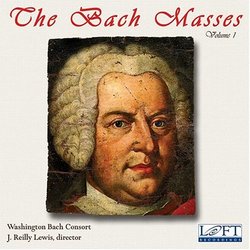| All Artists: Johann Sebastian Bach, Washington Bach Consort, Mary Ann Callahan, Robert Petillo Title: The Bach Masses, Vol. 1 Members Wishing: 0 Total Copies: 0 Label: Loft Recordings Release Date: 11/2/2004 Genre: Classical Styles: Opera & Classical Vocal, Chamber Music, Historical Periods, Baroque (c.1600-1750), Classical (c.1770-1830) Number of Discs: 1 SwapaCD Credits: 1 UPC: 617145106827 |
Search - Johann Sebastian Bach, Washington Bach Consort, Mary Ann Callahan :: The Bach Masses, Vol. 1
 | Johann Sebastian Bach, Washington Bach Consort, Mary Ann Callahan The Bach Masses, Vol. 1 Genre: Classical
This is an extremely notable first American recording of these masses by J.S. Bach, performed by the critically acclaimed American early-music group, the Washington Bach Consort. The success of Bach's B-minor Mass has obs... more » |
Larger Image |
CD Details
Synopsis
Album Description
This is an extremely notable first American recording of these masses by J.S. Bach, performed by the critically acclaimed American early-music group, the Washington Bach Consort. The success of Bach's B-minor Mass has obscured a number of his shorter masterpieces of the same genre. Written in the 1730s (when Bach was in his 40s, these masses -- which consist only of a Kyrie and Gloria setting -- could be performed in both Catholic and Lutheran liturgies. Sometimes misleadingly called "The Lutheran Masses," Bach used them to gain recognition from the Catholic court of Dresden, which bestowed upon him the title "Electoral Saxon and Royal Polish Court Compositeur." Later, he was to take one of these masses and expand it into the full B-minor Mass so popular today. The booklet contains notes by Christoph Wolff, a leading Bach scholar, tracing the history of these less-familiar masses and placing them in the context of the B-minor Mass and other works by Bach.

 Track Listings (13) - Disc #1
Track Listings (13) - Disc #1